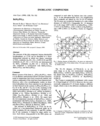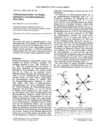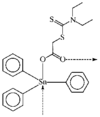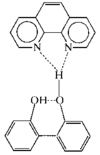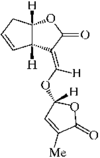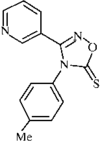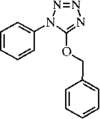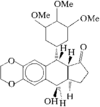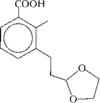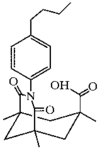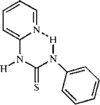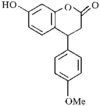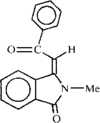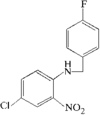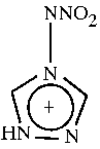issue contents
May 1999 issue

Cover illustration: The highly solvated structure of theonellapeptolide Id, a tridecapeptide lactone from the Okinawa marine sponge Theonella swinhoei, see Doi, Ishida, Kobayashi, Deschamps & Flippen-Anderson, pages 796-798. Displacement ellipsoids are shown at the 30% probability level.
cif-access (metal-organic compounds)
Download citation


Download citation


The nickel octahedron of the title compound is slightly distorted, with an average Ni—N distance of 2.146(13)Å.
Download citation


Download citation


The title compound consists of two identical [Cu(dien)]+ cations [dien is diethylenetriaminate(1−)] bridged by an imidazolyl ligand, three ClO4− anions and one water molecule. In the cation, the two Cu atoms are six-coordinate, being also bonded in a (4+2') fashion to perchlorate O atoms. The distance between the two Cu atoms is 5.889(2)Å.
Download citation


Download citation


The title compound has centrosymmetric Cu dimers linked by two end-on azido bridges. Each Cu atom has the five-coordinated geometry of a distorted trigonal bipyramid. The bridging azide anions are bound asymmetrically to copper at distances of 2.174(3) and 2.215(3)Å. The Cu⋯Cu distance is 3.129 (2) Å.
Download citation


Download citation


The asymmetric unit of the title compound contains two independent molecules, one Na atom and nine water molecules. The RuIII atom is tetracoordinated by the ethylenediaminetetraacetate (edta) ligand through two N and two carboxylate O atoms. The other two carboxylate groups of edta are free. The remaining two coordination positions of ruthenium(III) are occupied by Cl atoms.
Download citation


Download citation


The cyano and dialkylamino substituents in the title compound lie endo and exo with respect to the substituted ring plane. Data were collected using synchrotron radiation due to the small size of the only good quality crystal available.
Download citation


Download citation


The crystal structure of the title compound has been redetermined. It crystallizes in space group P1, which is the main difference from the previous determination [O'Connor, Eduok, Owens & Stevens (1986). Inorg. Chim. Acta, 117, 175–181].
cif-access (organic compounds)
Download citation


Download citation


The title compound has interesting biological activity. The three rings in the molecule are planar, with dihedral angles between their least-squares planes of 74.17, 65.15 and 90.69°. In the triazolium ring, the C—N bond lengths are almost equal, with values ranging between 1.315 and 1.340Å; this is due to π interaction.
Download citation


Download citation


The molecules of the title compound form a two-dimensional network linked by 8 and 24 hydrogen-bonded rings.
Download citation


Download citation


The title compound, N-4-[(benzenesulfonyl)amino]butylbenzenesulfonamide, is useful in the synthesis of natural or unnatural polyamine derivatives. The molecule is centrosymmetric with a straight-chain alkane core, and N—H⋯O intermolecular hydrogen bonds link the molecules into an infinite two-dimensional network.
Download citation


Download citation


In the title compound, the epoxy O atom is β-oriented. The presence of the epoxy group disturbs the chair conformation in ring A of the steroidal nucleus. Ring A has a half-chair conformation. The seven-membered B-ring conformation is midway between chair and twist-chair. The A/B junction is cis, and the B/C and C/D junctions are both trans. The molecules are held together by intermolecular O—H⋯O hydrogen bonding, forming a zigzag chain along the [010] direction.
Download citation


Download citation


In the title compound, the Br atom is β-equatorially oriented. The six-membered rings (A, B, C and F) have the expected chair conformations. The D-ring conformation is midway between a 14α-envelope and a 13β,14α-half-chair, and the E-ring conformation is midway between an O2α-envelope and a C21β,O2α-half-chair. The packing of the molecules is assumed to be mainly dictated by van der Waals forces. The closest intermolecular contact between non-H atoms is 3.300(9)Å.
Download citation


Download citation


In the crystal structure of the title compound, the five- and six-membered rings, together with the nitro substituent, are almost in the same plane. The torsion angle around the bond linking the aromatic ring and the Cl atom is 128.1(3)°.
Download citation


Download citation


The title compound was obtained as a by-product in the chlorination of a C5–C8 fused-ring compound. The formation of a cyclopropane ring, expected from 1H NMR spectroscopic analysis, was confirmed. The junction at the C—C bond between the seven- and three-membered rings is cis.
Download citation


Download citation


The structures of the four title compounds, C12H17BrO2, (I), C12H17BrO2, (II), C12H16Br2O2, (III), and C12H16Br2O2, (IV), which were obtained from the bromination of trans-4-methylbicyclo[6.3.0]undecane-2,6-dione, have been determined. The eight-membered rings in compounds (I)–(IV) take the boat–chair form.
inorganic compounds
Download citation


Download citation


The crystal structure of the title compound, barium dinickel(II) bis(phosphate), is isostructural with BaNi2(AsO4)2, BaNi2(VO4)2 and BaCo2(PO4)2. It is made up of dodecacoordinated barium ions, NiO6 octahedra and PO4 tetrahedra.
Download citation


Download citation


The cations and anions in the title compound are linked by hydrogen bonds to form 12-membered rings. The O⋯O distance [2.400 (3) Å] in the H5O2+ cation indicates a strong hydrogen bond. The anion, with formal inversion symmetry, has an almost regular octahedral structure.
metal-organic compounds
Download citation


Download citation


Download citation


Download citation


Download citation


Download citation


Download citation


Download citation


Download citation


Download citation


Download citation


Download citation


Download citation


Download citation


Download citation


Download citation


Download citation


Download citation


Download citation


Download citation


Download citation


Download citation


Download citation


Download citation


Download citation


Download citation


Download citation


Download citation


Download citation


Download citation


Download citation


Download citation


organic compounds
Download citation


Download citation


Download citation


Download citation


Download citation


Download citation


Download citation


Download citation


Download citation


Download citation


Download citation


Download citation


Download citation


Download citation


Download citation


Download citation


Download citation


Download citation


Download citation


Download citation


Download citation


Download citation


Download citation


Download citation


Download citation


Download citation


Download citation


Download citation


Download citation


Download citation


Download citation


Download citation


Download citation


Download citation


Download citation


Download citation


Download citation


Download citation


Download citation


Download citation


Download citation


Download citation


Download citation


Download citation


Download citation


Download citation


Download citation


Download citation


Download citation


Download citation


Download citation


Download citation


Download citation


Download citation


Download citation


Download citation


Download citation


Download citation


Download citation


Download citation


Download citation


Download citation


Download citation


Download citation


Download citation


Download citation


Download citation


Download citation


Download citation


Download citation


Download citation


Download citation




 journal menu
journal menu

























